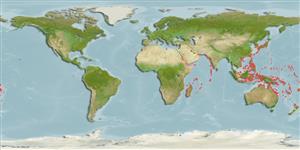Bivalvia |
Pectinida |
Pectinidae
Environment: milieu / climate zone / depth range / distribution range
Ecology
Benthic; depth range 0 - 10 m (Ref. 2922). Tropical
Indo-Pacific.
Length at first maturity / Size / Weight / Age
Maturity: Lm ? range ? - ? cm Max length : 1.7 cm TL male/unsexed; (Ref. 2922)
Life cycle and mating behavior
Maturity | Reproduction | Spawning | Eggs | Fecundity | Larvae
Members of the class Bivalvia are mostly gonochoric, some are protandric hermaphrodites. Life cycle: Embryos develop into free-swimming trocophore larvae, succeeded by the bivalve veliger, resembling a miniature clam.
Oliver, P.G., A.M. Holmes, I.J. Killeen, J.M. Light and H. Wood 2004 Annotated checklist of the marine Bivalvia of Rodrigues. Journal of Natural History 38:3229-3272. (Ref. 2922)
IUCN Red List Status
(Ref. 130435: Version 2025-1)
CITES status (Ref. 108899)
Not Evaluated
Not Evaluated
Threat to humans
Harmless
Human uses
| FishSource |
Tools
More information
Trophic EcologyFood items (preys)
Diet composition
Food consumption
Predators
Population dynamicsGrowth
Max. ages / sizes
Length-weight rel.
Length-length rel.
Length-frequencies
Mass conversion
Abundance
Life cycleReproductionMaturityFecunditySpawningEggsEgg developmentLarvae PhysiologyOxygen consumption
Human RelatedStamps, coins, misc.
Internet sources
Estimates based on models
Preferred temperature
(Ref.
115969): 23.8 - 29.3, mean 28.2 (based on 2190 cells).
Fishing Vulnerability
Low vulnerability (10 of 100).
